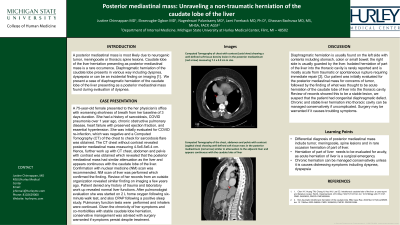Back


Poster Session D - Tuesday Morning
Category: Liver
D0543 - Posterior Mediastinal Mass: Unraveling a Non-Traumatic Herniation of the Caudate Lobe of the Liver
Tuesday, October 25, 2022
10:00 AM – 12:00 PM ET
Location: Crown Ballroom

Has Audio

Justine Chinnappan, MD
Hurley Medical Center
Flint, MI
Presenting Author(s)
Justine M. Chinnappan, MD1, Nageshwari Palanisamy, MD2, Ekwevugbe Ogbon, MD2, Jami Foreback, MD2, Ghassan Bachuwa, MD, MS, MHSA1
1Hurley Medical Center, Flint, MI; 2Hurley Medical Center at Michigan State University, Flint, MI
Introduction: Posterior mediastinal mass is most likely due to neurogenic tumor, meningocele or thoracic spine lesions. Caudate lobe of the liver herniation presenting as posterior mediastinal mass is a rare occurrence. Diaphragmatic herniation (DH) of the caudate lobe presents in various way including dyspnea, dyspepsia or incidental finding on imaging. We present a case of diaphragmatic hernia of the caudate lobe of the liver presenting as a posterior mediastinal mass found during evaluation of dyspnea.
Case Description/Methods: A 75-year-old female presented to her physician with worsening shortness of breath from her baseline of 3 days duration. She had a history of sarcoidosis, COVID pneumonia over 1 year ago, COPD, diastolic heart failure, and hypertension. She was initially evaluated for COVID re-infection, which was negative and a CT of the chest with contrast to check for sarcoidosis flare revealed posterior mediastinal mass measuring 4.5x6.5x6.4 cm. Further work up with CT chest and abdomen with contrast revealed that the posterior mediastinal mass had similar attenuation as the liver and appears continuous with the caudate lobe of the liver. This was confirmed by NM scan of liver. Review of her records from an outside organization revealed similar finding on imaging a few years ago. Patient denied any history of trauma and laboratory work up revealed normal liver functions. After pulmonologist evaluation she was started on 2 L home oxygen following six-minute walk test, and also CPAP following a positive sleep study. Pulmonary function tests were performed and inhalers were continued. Given the chronicity of her symptoms and co-morbidities with stable caudate lobe herniation, conservative management was advised with surgery warranted if symptoms persist despite treatment.
Discussion: DH is typically found on the left side with stomach or intestine while the right side is usually guarded by the liver. Isolated herniation of part of the liver into the thoracic cavity is rarely reported and is mostly acute from traumatic or spontaneous rupture requiring immediate repair. Our patient was initially evaluated for the posterior mediastinal mass for concerns of tumor, followed by the finding of what was thought to be acute herniation of the caudate lobe of liver into the thoracic cavity. Review of records showed this to be a stable lesion, we suspect that the patient had congenital diaphragmatic defect. Chronic and stable liver herniation into thoracic cavity can be managed conservatively if uncomplicated.

Disclosures:
Justine M. Chinnappan, MD1, Nageshwari Palanisamy, MD2, Ekwevugbe Ogbon, MD2, Jami Foreback, MD2, Ghassan Bachuwa, MD, MS, MHSA1. D0543 - Posterior Mediastinal Mass: Unraveling a Non-Traumatic Herniation of the Caudate Lobe of the Liver, ACG 2022 Annual Scientific Meeting Abstracts. Charlotte, NC: American College of Gastroenterology.
1Hurley Medical Center, Flint, MI; 2Hurley Medical Center at Michigan State University, Flint, MI
Introduction: Posterior mediastinal mass is most likely due to neurogenic tumor, meningocele or thoracic spine lesions. Caudate lobe of the liver herniation presenting as posterior mediastinal mass is a rare occurrence. Diaphragmatic herniation (DH) of the caudate lobe presents in various way including dyspnea, dyspepsia or incidental finding on imaging. We present a case of diaphragmatic hernia of the caudate lobe of the liver presenting as a posterior mediastinal mass found during evaluation of dyspnea.
Case Description/Methods: A 75-year-old female presented to her physician with worsening shortness of breath from her baseline of 3 days duration. She had a history of sarcoidosis, COVID pneumonia over 1 year ago, COPD, diastolic heart failure, and hypertension. She was initially evaluated for COVID re-infection, which was negative and a CT of the chest with contrast to check for sarcoidosis flare revealed posterior mediastinal mass measuring 4.5x6.5x6.4 cm. Further work up with CT chest and abdomen with contrast revealed that the posterior mediastinal mass had similar attenuation as the liver and appears continuous with the caudate lobe of the liver. This was confirmed by NM scan of liver. Review of her records from an outside organization revealed similar finding on imaging a few years ago. Patient denied any history of trauma and laboratory work up revealed normal liver functions. After pulmonologist evaluation she was started on 2 L home oxygen following six-minute walk test, and also CPAP following a positive sleep study. Pulmonary function tests were performed and inhalers were continued. Given the chronicity of her symptoms and co-morbidities with stable caudate lobe herniation, conservative management was advised with surgery warranted if symptoms persist despite treatment.
Discussion: DH is typically found on the left side with stomach or intestine while the right side is usually guarded by the liver. Isolated herniation of part of the liver into the thoracic cavity is rarely reported and is mostly acute from traumatic or spontaneous rupture requiring immediate repair. Our patient was initially evaluated for the posterior mediastinal mass for concerns of tumor, followed by the finding of what was thought to be acute herniation of the caudate lobe of liver into the thoracic cavity. Review of records showed this to be a stable lesion, we suspect that the patient had congenital diaphragmatic defect. Chronic and stable liver herniation into thoracic cavity can be managed conservatively if uncomplicated.

Figure: Figure 1: (A) Computed Tomography of chest with contrast (axial view) showing a well-defined soft tissue density lesion in the posterior mediastinum (red arrow). (B) Computed Tomography of the chest, abdomen and pelvis with contrast (sagittal view) showing well defined soft tissue mass in the posterior mediastinum (red arrow) similar in attenuation to the adjacent liver and appears continuous with the caudate lobe of liver
Disclosures:
Justine Chinnappan indicated no relevant financial relationships.
Nageshwari Palanisamy indicated no relevant financial relationships.
Ekwevugbe Ogbon indicated no relevant financial relationships.
Jami Foreback indicated no relevant financial relationships.
Ghassan Bachuwa indicated no relevant financial relationships.
Justine M. Chinnappan, MD1, Nageshwari Palanisamy, MD2, Ekwevugbe Ogbon, MD2, Jami Foreback, MD2, Ghassan Bachuwa, MD, MS, MHSA1. D0543 - Posterior Mediastinal Mass: Unraveling a Non-Traumatic Herniation of the Caudate Lobe of the Liver, ACG 2022 Annual Scientific Meeting Abstracts. Charlotte, NC: American College of Gastroenterology.
